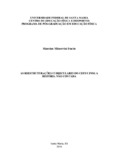| dc.creator | Fuchs, Marcius Minervini | |
| dc.date.accessioned | 2016-07-12 | |
| dc.date.available | 2016-07-12 | |
| dc.date.issued | 2016-03-15 | |
| dc.identifier.citation | FUCHS, Marcius Minervini. THE CURRICULUM RESTRUCTURINGS OF CEFD/UFSM: THE UNTOLD STORY. 2016. 191 f. Dissertação (Mestrado em Educação Física) - Universidade Federal de Santa Maria, Santa Maria, 2016. | por |
| dc.identifier.uri | http://repositorio.ufsm.br/handle/1/6738 | |
| dc.description.abstract | This research is in the midst of discussions about educational public policies and formation of physical education teachers. It enters in the discussions of the research line Social-cultural and educational aspects of Physical Education more specifically on teacher training. The study researched how they were created, specifically about teacher training. The study researched how the correlations of strength of actors were given in the processes of curricular restructuring of CEFD/UFSM that resulted in the curricula of 2005 (Degree), 2006 (Bachelor) and 2009 (Constitution of the joint committee for the construction of a formation curriculum only in Degree) from bibliographical study, document analysis and semi-structured interviews. The social actors who were involved in their respective committees of curriculum restructuring were interviewed. The study has as its main objective analyze and document these restructuring processes from the analysis of the correlation of forces of social actors and their roles in the implementation of the educational public policies related to curriculum guidelines or their resistance. In the data analysis it is realized that sectors were structured with proposals of opposing projects that came in a dispute from the beginning. After researching, the constitution processes of the current curricula in vogue, it is raised the hypothesis that these relations were stabilized with agreements, creating a consensus between the parties. In the reunification process the student struggle was the protagonist, however, the majority sector of the teachers managed to use the institutional apparatus to halt the process, which was not approved until the present day. Therefore, CEFD continues with the fragmented training, and the individual interests overcome the the collective interests. | eng |
| dc.format | application/pdf | por |
| dc.language | por | por |
| dc.publisher | Universidade Federal de Santa Maria | por |
| dc.rights | Acesso Aberto | por |
| dc.subject | Reestruturações curriculares | por |
| dc.subject | Atores sociais | por |
| dc.subject | Formação inicial | por |
| dc.subject | Professores | por |
| dc.subject | Educação física | por |
| dc.subject | Curriculum restructuring | eng |
| dc.subject | Social actors | eng |
| dc.subject | Inicial formation | eng |
| dc.subject | Teachers | eng |
| dc.subject | Physical education | eng |
| dc.title | As reestruturações curriculares do CEFD/UFSM: a história não contada | por |
| dc.title.alternative | The curriculum restructurings of CEFD/UFSM: the untold story | eng |
| dc.type | Dissertação | por |
| dc.description.resumo | Esta pesquisa está no bojo das discussões sobre políticas públicas educacionais e formação de professores em educação física. Ela adentra na discussão da linha de pesquisa "Aspectos Sócio-culturais e pedagógicos da Educação Física" mais especificamente sobre formação de professores. O Trabalho pesquisou como se deram as correlações de forças dos atores sociais nos processos de reestruturações curriculares do CEFD/UFSM que resultaram nos currículos de 2005 (Licenciatura), 2006 (Bacharelado) e 2009 (Constituição da comissão paritária para construção de um currículo de formação única em Licenciatura) a partir de estudo bibliográfico, análise documental e entrevistas semi-estruturadas. Foram entrevistados os atores sociais que se envolveram nas respectivas comissões de reestruturação curricular e direção de centro. Tem como principal objetivo analisar e documentar estes processos de reestruturações a partir da análise das correlações de forças dos atores sociais e seus papéis para a implementação das políticas públicas educacionais referentes às diretrizes curriculares ou resistência às mesmas. Na análise dos dados percebemos que se estruturaram setores com propostas de projetos antagônicos que entraram em uma disputa desde o princípio. Após pesquisar, os processos de constituição dos atuais currículos em voga, elevamos a hipótese de que estas relações se estabilizaram com acordos, criando um consenso entre as partes. Já no processo de reunificação a luta estudantil foi protagonista, porém o setor majoritário dos professores conseguiu se utilizar dos aparatos institucionais para travar o processo, no qual não foi aprovado até os dias atuais. Assim o CEFD continua com a formação fragmentada, e os interesses individuais superam os coletivos. | por |
| dc.contributor.advisor1 | Souza, Maristela da Silva | |
| dc.contributor.advisor1Lattes | http://lattes.cnpq.br/7685329921498975 | por |
| dc.contributor.referee1 | Frizzo, Giovanni Felipe Ernst | |
| dc.contributor.referee1Lattes | http://lattes.cnpq.br/2344138672288053 | por |
| dc.contributor.referee2 | Kunz, Elenor | |
| dc.contributor.referee2Lattes | http://lattes.cnpq.br/0451631464832830 | por |
| dc.creator.Lattes | http://lattes.cnpq.br/3718775467799240 | por |
| dc.publisher.country | BR | por |
| dc.publisher.department | Educação Física | por |
| dc.publisher.initials | UFSM | por |
| dc.publisher.program | Programa de Pós-Graduação em Educação Física | por |
| dc.subject.cnpq | CNPQ::CIENCIAS DA SAUDE::EDUCACAO FISICA | por |


